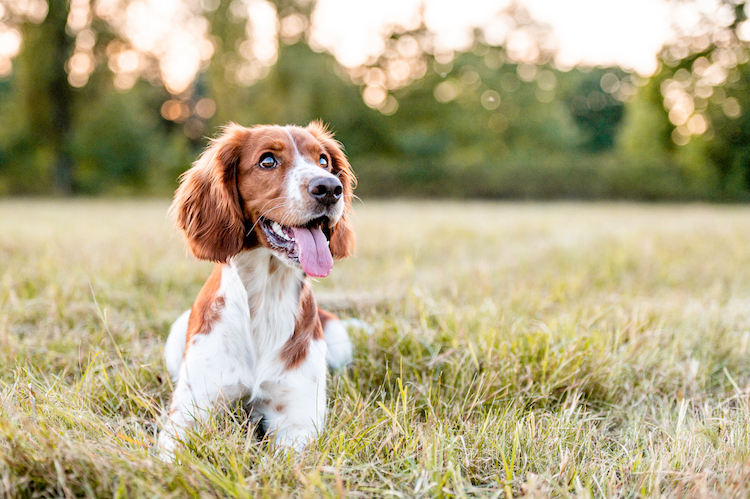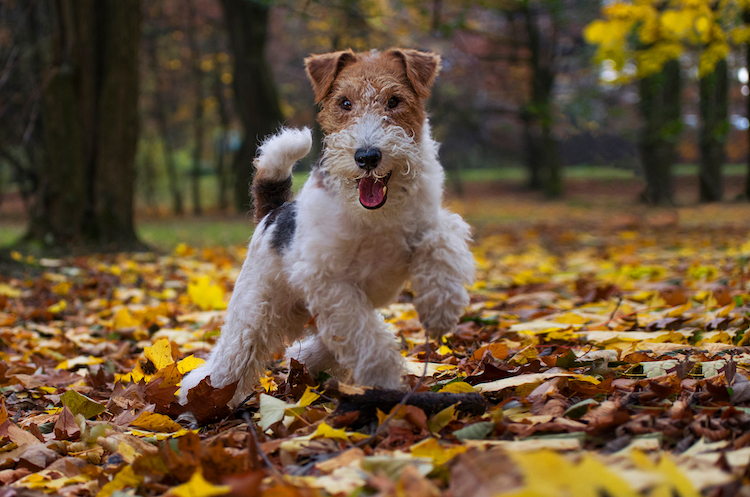We spend a lot of time on this site advising dog owners to look out for extra pounds on their pups—and with good reason. Nearly 60% of dogs in the U.S. are overweight or obese, and excess weight can cause serious health problems. But too little weight and muscle mass is also a health hazard. If you’ve adopted a dog who is underweight—or if your current companion has lost weight, or is otherwise having trouble achieving their ideal weight—it’s important to make a plan to help them put on pounds, safely. Here’s how to confirm that your dog really is thinner than they should be—and, if they are, how to help them reach an ideal weight and body condition.
First, check your dog’s body condition and consult a veterinarian
Some dogs whose humans think they’re underweight are actually in fine shape. A healthy dog might look leaner than you think. Before you assume that your dog needs to gain weight, check their body condition. As a general rule, a dog probably isn’t underweight unless you can clearly see (not just feel) all of their ribs. In most cases, dogs who are underweight will also show other signs that something’s wrong—if your dog is happy, has a shiny coat, and has plenty of energy to play, chances are they’re getting enough nourishment.
We have more tips on how to measure your dog’s body condition here. To make sure that your dog is at the right weight and body condition, consult a veterinarian.
If there’s a medical issue, address it
Once you know that your dog is underweight, you will need to figure out why. This is best done in conjunction with your dog’s vet healthcare team. Dogs may lose weight because they’re sick, and when that’s the case it’s important to treat whatever is ailing them. A wide range of illnesses can cause weight loss, and a veterinary professional can work with you to determine if your dog has an underlying health issue that requires more than just some extra food. Factors like anxiety or drug reactions may affect your dog’s appetite, so speak to your vet if there are any changes or added stressors in your dog’s life that may be manifesting in weight fluctuation.

Make sure that your dog’s food is complete and balanced—and digestible
Some diets don’t give dogs all of the nutrients they need to thrive over the long term. While it’s a caring gesture to feed a dog homemade food prepared in your own kitchen—our company was founded by someone who discovered the benefits of switching from heavily processed kibble to real, fresh fare—it is also very difficult to keep a dog in good health that way without help from a professional. Research has shown that many recipes for homemade dog food can result in nutritional imbalances. That’s why, as mentioned above, our recipes are designed by veterinary nutritionists. If you do cook at home, talk to a veterinarian about how to get all of the right nutrients into your dog’s daily diet at the outset, before any deficiencies arise.
Some healthy treats can be a positive thing; they’re a great way to reward your friend during training, but they should make up no more than 10% of any dog’s calories. Anything more could throw off their nutritional balance. If you’re looking for a healthy treat choice, we recommend our own Snap Sticks, which—like all of our food—are made with only human-grade ingredients in USDA-inspected kitchens.
And if healthy weight gain is your goal, it’s a good idea to look at your pet food’s digestibility. While many pet foods can claim to be complete and balanced, there can be huge variation in how digestible they are. Digestibility is, simply, how much of a food’s nutritional value can be absorbed into the bloodstream. You may have also seen the term “bioavailability,” a closely related term which means the proportion of a nutrient that enters the bloodstream and can be used by the body’s tissues. Multiple studies (including our own) have found that fresh, lightly cooked food has superior digestibility and bioavailability versus highly processed dry food. The Farmer’s Dog makes its recipes with human-grade meat and produce, balanced with vitamins and minerals. All of our ingredients, and the kitchens where the food is cooked and handled, meet USDA standards. The result is that you know what’s going in the bowl, and your dog is actually getting the powerful nutrients from the food.
Be precise about portions
Of course, once you’ve ruled out a health issue, perhaps the biggest factor in managing your dog’s weight is getting their food portions right. Dogs may lose weight, or not put on as much as they need, if they’re not getting sufficient calories for their life stage, weight, activity level, and other factors. If your dog is underweight and they’re eating food that’s complete and balanced for their life stage, they may simply not be getting enough of it. Talk to a vet about portioning, and make deliberate, careful changes under their guidance. This will help your dog get used to a new routine, and will give you an indication of what’s working. If you want some help giving your dog exactly as much food as they need each day, you may want to consider a pre-portioned fresh food plan to make it easier. By asking about your dog’s weight, age, body condition, activity level, spay/neuter status, and other information, we can tailor their portions to their unique needs. And it’s easy to adjust portions as your dog gains weight or their needs change.

If your dog is a puppy (or a senior), make sure they’re eating food that’s appropriate for their life stage
If your otherwise healthy dog can’t seem to gain weight, their food may not be suitable for their current life stage. This can be an issue during puppyhood, a period when precisely balanced nutrition is especially crucial for growth.
Not all dog foods are suitable for puppies—some companies’ food for adult dogs doesn’t meet growing pups’ requirements. Fresh recipes from The Farmer’s Dog are formulated by veterinary nutritionists to be complete and balanced for all life stages, including puppyhood, so humans who follow the proper guidelines can begin feeding it as soon as their puppy is weaning.
On the other end of the spectrum, if your senior dog has lost or gained weight as they’ve gotten older, talking to a veterinarian about the healthiest choices for them can help.
Balance is also important for seniors—providing the right amount of nutrients in the right ratios so you’re not taxing their bodies by depriving them of, or over-supplying certain nutrients. Providing those nutrients through fresh, highly digestible food can be a great option for seniors who may need to gain weight or muscle mass.
Fresh, whole food provides some other benefits that are especially relevant to seniors—it’s soft and easy to eat, and it contains more moisture than dried, heavily-processed pellets, helping to keep your dog’s body hydrated, aiding digestion and elimination.
If your senior needs a bit of a boost in the digestion department, consider adding a little plain pumpkin or some pureed vegetables for fiber.
See if you can make your dog’s food more appetizing
If your dog isn’t eating their food, and you’re sure it’s not because they’re sick, you can try motivating them to eat more. Dogs have an excellent sense of smell, so it’s possible that they’re noticing that their food has gone bad or their food bowl is dirty. Make sure to keep food and water bowls clean. Consider switching foods if your dog seems not to like what they’re eating (lots of dogs who seemed to be picky eaters when offered kibble have turned out to have much more of a taste for fresh food). A pre-meal walk or using a dog’s food as a reward during games or training can also sometimes help a pup work up an appetite.
If your dog isn’t gaining weight even though they need to, talk to a vet
There are numerous reasons that a dog might have trouble gaining weight, and many of them can be addressed with the right plan and support. You’ll put yourself and your pup in the best position to succeed by seeking out a veterinarian as soon as possible to get an overview of their circumstances and outline your next steps toward helping them meet their nutritional needs and achieve good overall health.









